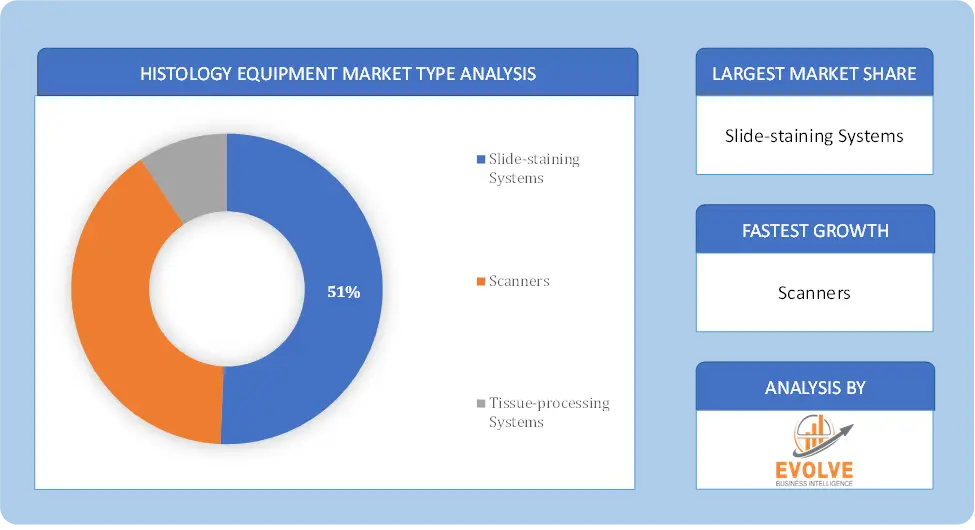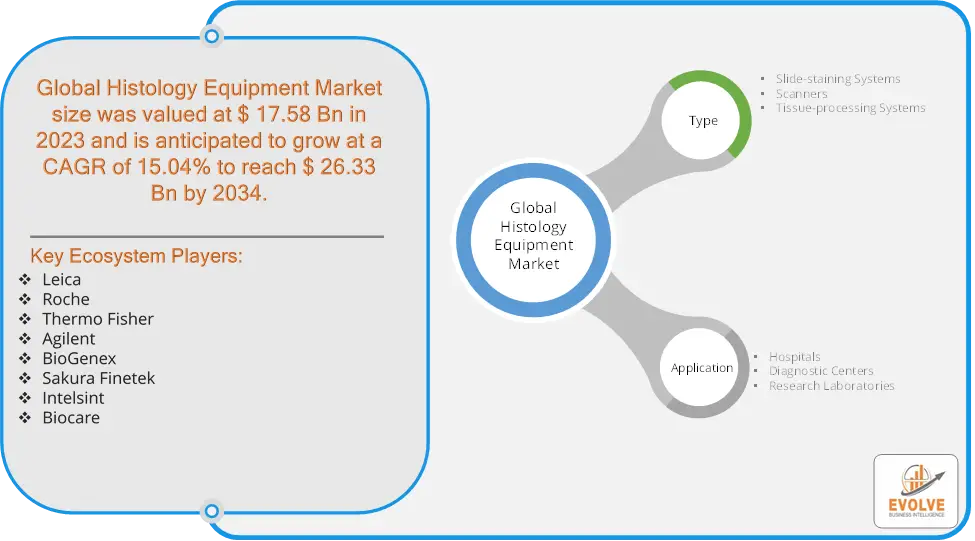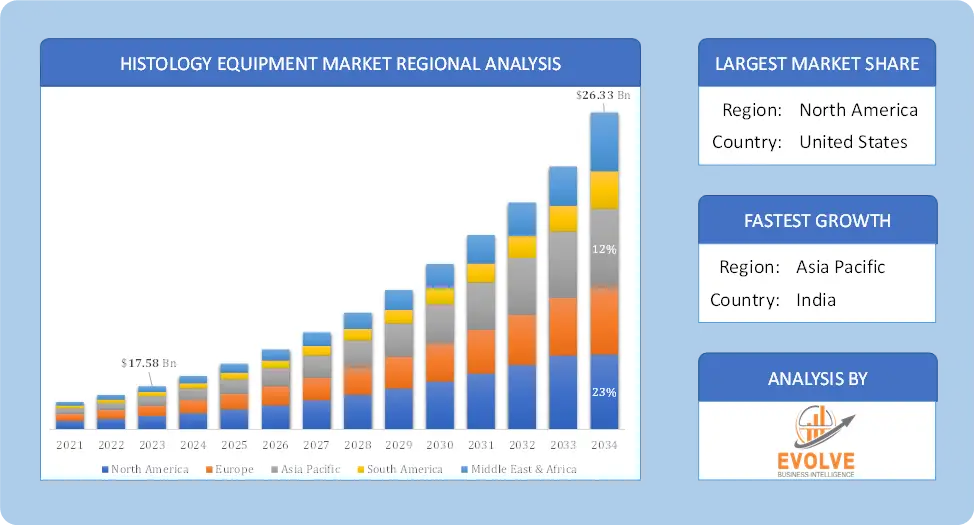Histology Equipment Market Analysis and Global Forecast 2024-2034
€ 1,230.43 – € 4,886.30Price range: € 1,230.43 through € 4,886.30
Histology Equipment Market Research Report: Information By Type (Slide-staining Systems, Scanners, and Tissue-processing Systems), By Application (Hospitals, Diagnostic Centers, and Research Laboratories), and by Region — Forecast till 2034
Page: 170
Histology Equipment Market Overview
The Histology Equipment Market size accounted for USD 17.58 Billion in 2023 and is estimated to account for 18.20 Billion in 2024. The Market is expected to reach USD 26.33 Billion by 2034 growing at a compound annual growth rate (CAGR) of 15.04% from 2024 to 2034. The Histology Equipment Market refers to the industry that produces and sells devices and tools used in the field of histology. Histology is the study of the microscopic structure of tissues and cells, which plays a crucial role in diagnosing diseases and conducting medical research.
The histology equipment market is driven by factors such as increasing prevalence of chronic diseases, advancements in technology, and growing demand for personalized medicine. The market is expected to continue to grow in the coming years, as new and innovative technologies are developed to improve the efficiency and accuracy of histological analysis.
Global Histology Equipment Market Synopsis
 Histology Equipment Market Dynamics
Histology Equipment Market Dynamics
The major factors that have impacted the growth of Histology Equipment Market are as follows:
Drivers:
Ø Advancements in Medical and Diagnostic Technologies
Technological advancements in histology equipment, such as automation, digital pathology, and AI-driven diagnostic tools, are improving the accuracy and speed of tissue analysis. These innovations increase efficiency and precision, boosting the demand for modern histology equipment. Pharmaceutical and biotech companies rely on histology techniques during the preclinical stages of drug development to understand disease mechanisms and assess the effects of new drugs. This dependence on histology equipment for research and development (R&D) fosters market growth.
Restraint:
- Perception of High Cost of Equipment and Technological Obsolescence
Advanced histology equipment can be expensive, making it less accessible for smaller laboratories and clinics. The high initial investment can deter some healthcare providers from upgrading their equipment or expanding their services. Rapid advancements in histology technologies can render existing equipment outdated. Laboratories may hesitate to invest in new equipment if they fear it will quickly become obsolete or require frequent upgrades.
Opportunity:
⮚ Growing Demand for Digital Pathology
The shift towards digital pathology offers significant opportunities for histology equipment manufacturers. Digital imaging and analysis systems can improve the accuracy of diagnoses and facilitate remote consultations, enhancing workflow efficiency in laboratories. Continued advancements in automation technologies for histology processes can lead to more efficient workflows and reduced turnaround times. Companies that develop and market automated systems can gain a competitive advantage.
Histology Equipment Market Segment Overview
By Type
 Based on Type, the market is segmented based on Slide-staining Systems, Scanners, and Tissue-processing Systems. The Slide-staining Systems segment dominant the market, due to its wide range of uses such as tissue processing, immunohistochemistry, and cytogenetics stain. Scanners are expected to witness high growth during the forecast period owing to their ability to produce high resolution and clear images.
Based on Type, the market is segmented based on Slide-staining Systems, Scanners, and Tissue-processing Systems. The Slide-staining Systems segment dominant the market, due to its wide range of uses such as tissue processing, immunohistochemistry, and cytogenetics stain. Scanners are expected to witness high growth during the forecast period owing to their ability to produce high resolution and clear images.
By Application
Based on Application, the market segment has been divided into Hospitals, Diagnostic Centers, and Research Laboratories. The Diagnostic Centers segment dominant the market, as the number of autopsies carried out in these centers is increasing. The need for earlier diagnosis of infectious diseases has led to higher adoption of histology equipment such as laboratory workflow, tissue embedders, and cryostats.
Global Histology Equipment Market Regional Analysis
Based on region, the global Histology Equipment Market has been divided into North America, Europe, Asia-Pacific, the Middle East & Africa, and Latin America. North America is projected to dominate the use of the Histology Equipment Market followed by the Asia-Pacific and Europe regions.
 Global Histology Equipment North America Market
Global Histology Equipment North America Market
North America holds a dominant position in the Histology Equipment Market. North America holds a significant share of the global histology equipment market, primarily due to advanced healthcare infrastructure, high healthcare spending, and a strong focus on research and development and the presence of leading manufacturers, increasing prevalence of cancer, and advancements in digital pathology and automation technologies drive growth.
Global Histology Equipment Asia-Pacific Market
The Asia-Pacific region has indeed emerged as the fastest-growing market for the Histology Equipment Market industry. The Asia-Pacific market is experiencing rapid growth, driven by factors such as increasing healthcare spending, rising population, and growing awareness of the importance of early disease detection and growing populations, increasing incidence of chronic diseases, and government initiatives to improve healthcare access contribute to market growth.
Competitive Landscape
The global Histology Equipment Market is highly competitive, with numerous players offering a wide range of software solutions. The competitive landscape is characterized by the presence of established companies, as well as emerging startups and niche players. To increase their market position and attract a wide consumer base, the businesses are employing various strategies, such as product launches, and strategic alliances.
Prominent Players:
- Leica
- Roche
- Thermo Fisher
- Agilent
- BioGenex
- Sakura Finetek
- Intelsint
- Biocare
Scope of the Report
Global Histology Equipment Market, by Type
- Slide-staining Systems
- Scanners
- Tissue-processing Systems
Global Histology Equipment Market, by Application
- Hospitals
- Diagnostic Centers
- Research Laboratories
Global Histology Equipment Market, by Region
- North America
- US
- Canada
- Mexico
- Europe
- UK
- Germany
- France
- Italy
- Spain
- Benelux
- Nordic
- Rest of Europe
- Asia Pacific
- China
- Japan
- South Korea
- Indonesia
- Austalia
- Malaysia
- India
- Rest of Asia Pacific
- South America
- Brazil
- Argentina
- Rest of South America
- Middle East & Africa
- Saudi Arabia
- UAE
- Egypt
- South Africa
- Rest of Middle East & Africa
| Parameters | Indicators |
|---|---|
| Market Size | 2033: $26.33 Billion |
| CAGR | 15.04% CAGR (2023-2033) |
| Base year | 2022 |
| Forecast Period | 2023-2033 |
| Historical Data | 2021 |
| Report Coverage | Revenue Forecast, Competitive Landscape, Growth Factors, and Trends |
| Key Segmentations | Type, Application |
| Geographies Covered | North America, Europe, Asia-Pacific, Latin America, Middle East, Africa |
| Key Vendors | Leica, Roche, Thermo Fisher, Agilent, BioGenex, Sakura Finetek, Intelsint and Biocare |
| Key Market Opportunities | • Growing Demand for Digital Pathology • Advancements in Automation |
| Key Market Drivers | • Advancements in Medical and Diagnostic Technologies • Increased Focus on Drug Development and Research |
REPORT CONTENT BRIEF:
- High-level analysis of the current and future Histology Equipment Market trends and opportunities
- Detailed analysis of current market drivers, restraining factors, and opportunities in the future
- Histology Equipment Market historical market size for the year 2021, and forecast from 2023 to 2033
- Histology Equipment Market share analysis at each product level
- Competitor analysis with detailed insight into its product segment, Government & Defense strength, and strategies adopted.
- Identifies key strategies adopted including product launches and developments, mergers and acquisitions, joint ventures, collaborations, and partnerships as well as funding taken and investment done, among others.
- To identify and understand the various factors involved in the global Histology Equipment Market affected by the pandemic
- To provide a detailed insight into the major companies operating in the market. The profiling will include the Government & Defense health of the company’s past 2-3 years with segmental and regional revenue breakup, product offering, recent developments, SWOT analysis, and key strategies.
Press Release

Global Pharmaceutical Manufacturing Market to Reach $1.38 Trillion by 2035 with 7.35% CAGR, New Research Shows

The Global Mammography Market Is Estimated To Record a CAGR of Around 10.29% During The Forecast Period

Glue Stick Market to Reach USD 2.35 Billion by 2034

Podiatry Service Market to Reach USD 11.88 Billion by 2034

Microfluidics Technology Market to Reach USD 32.58 Billion by 2034

Ferric Chloride Market to Reach USD 10.65 Billion by 2034

Family Practice EMR Software Market to Reach USD 21.52 Billion by 2034

Electric Hairbrush Market to Reach USD 15.95 Billion by 2034

Daily Bamboo Products Market to Reach USD 143.52 Billion by 2034

Cross-border E-commerce Logistics Market to Reach USD 112.65 Billion by 2034
Frequently Asked Questions (FAQ)
What is the study period of this market?
The study period of the global Histology Equipment Market is 2021- 2033
What is the growth rate of the global Histology Equipment Market?
The global Histology Equipment Market is growing at a CAGR of 15.04% over the next 10 years
Which region has the highest growth rate in the market of Histology Equipment Market?
Asia Pacific is expected to register the highest CAGR during 2024-2034
Which region has the largest share of the global Histology Equipment Market?
North America holds the largest share in 2022
Who are the key players in the global Histology Equipment Market?
Leica, Roche, Thermo Fisher, Agilent, BioGenex, Sakura Finetek, Intelsint and Biocare. are the major companies operating in the market
Do you offer Post Sale Support?
Yes, we offer 16 hours of analyst support to solve the queries
Do you sell particular sections of a report?
Yes, we provide regional as well as country-level reports. Other than this we also provide a sectional report. Please get in contact with our sales representatives
Table of Contents
Chapter 1. Executive Summary Chapter 2. Scope Of Study 2.1. Market Definition 2.2. Scope Of The Study 2.2.1. Objectives of Report 2.2.2. Limitations 2.3. Market Structure Chapter 3. Evolve BI Methodology Chapter 4. Market Insights and Trends 4.1. Supply/ Value Chain Analysis 4.1.1. Raw Application Providers 4.1.2. Manufacturing Process 4.1.3. Distributors/Retailers 4.1.4. End Users 4.2. Porter’s Five Forces Analysis 4.2.1. Threat Of New Entrants 4.2.2. Bargaining Power Of Buyers 4.2.3. Bargaining Power Of Suppliers 4.2.4. Threat Of Substitutes 4.2.5. Industry Rivalry 4.3. Impact Of COVID-19 on Histology Equipment Market 4.3.1. Impact on Market Size 4.3.2. End-User Trend, Preferences, and Budget Impact 4.3.3. Regulatory Framework/Government Policies 4.3.4. Key Players' Strategy to Tackle Negative Impact 4.3.5. Opportunity Window 4.4. Technology Overview 4.5. Macro factor 4.6. Micro Factor 4.7. Demand Supply Gap Analysis of Histology Equipment Market 4.8. Import Analysis of Histology Equipment Market 4.9. Export Analysis of Histology Equipment Market Chapter 5. Market Dynamics 5.1. Introduction 5.2. DROC Analysis 5.2.1. Drivers 5.2.2. Restraints 5.2.3. Opportunities 5.2.4. Challenges 5.3. Patent Analysis 5.4. Industry Roadmap 5.5. Parent/Peer Market Analysis Chapter 6. Global Histology Equipment Market, By Type 6.1. Introduction 6.2. Slide-staining Systems 6.3. Scanners 6.4 Tissue-processing Systems Chapter 7. Global Histology Equipment Market, By Application 7.1. Introduction 7.2. Hospitals 7.3. Diagnostic Centers 7.4 Research Laboratories Chapter 8. Global Histology Equipment Market, By Region 8.1. Introduction 8.2. North America 8.2.1. Introduction 8.2.2. Driving Factors, Opportunity Analyzed, and Key Trends 8.2.3. Market Size and Forecast, By Country, 2020 - 2028 8.2.4. Market Size and Forecast, By Product Type, 2020 - 2028 8.2.5. Market Size and Forecast, By Application, 2020 – 2028 8.2.6. US 8.2.6.1. Introduction 8.2.6.2. Driving Factors, Opportunity Analyzed, and Key Trends 8.2.6.3. Market Size and Forecast, By Product Type, 2020 - 2028 8.2.6.4. Market Size and Forecast, By Application, 2020 - 2028 8.2.7. Canada 8.2.7.1. Introduction 8.2.7.2. Driving Factors, Opportunity Analyzed, and Key Trends 8.2.7.3. Market Size and Forecast, By Product Type, 2020 - 2028 8.2.7.4. Market Size and Forecast, By Application, 2020 - 2028 8.3. Europe 8.3.1. Introduction 8.3.2. Driving Factors, Opportunity Analyzed, and Key Trends 8.3.3. Market Size and Forecast, By Country, 2020 - 2028 8.3.4. Market Size and Forecast, By Product Type, 2020 - 2028 8.3.5. Market Size and Forecast, By Application, 2020 – 2028 8.3.6. Germany 8.3.6.1. Introduction 8.3.6.2. Driving Factors, Opportunity Analyzed, and Key Trends 8.3.6.3. Market Size and Forecast, By Product Type, 2020 - 2028 8.3.6.4. Market Size and Forecast, By Application, 2020 - 2028 8.3.7. France 8.3.7.1. Introduction 8.3.7.2. Driving Factors, Opportunity Analyzed, and Key Trends 8.3.7.3. Market Size and Forecast, By Product Type, 2020 - 2028 8.3.7.4. Market Size and Forecast, By Application, 2020 - 2028 8.3.8. UK 8.3.8.1. Introduction 8.3.8.2. Driving Factors, Opportunity Analyzed and Key Trends 8.3.8.3. Market Size and Forecast, By Product Type, 2020 - 2028 8.3.8.4. Market Size and Forecast, By Application, 2020 - 2028 8.3.9. Italy 8.3.9.1. Introduction 8.3.9.2. Driving Factors, Opportunity Analyzed, and Key Trends 8.3.9.3. Market Size and Forecast, By Product Type, 2020 - 2028 8.3.9.4. Market Size and Forecast, By Application, 2020 - 2028 8.3.10. Rest Of Europe 8.3.10.1. Introduction 8.3.10.2. Driving Factors, Opportunity Analyzed, and Key Trends 8.3.10.3. Market Size and Forecast, By Product Type, 2020 - 2028 8.3.10.4. Market Size and Forecast, By Application, 2020 - 2028 8.4. Asia-Pacific 8.4.1. Introduction 8.4.2. Driving Factors, Opportunity Analyzed, and Key Trends 8.4.3. Market Size and Forecast, By Country, 2020 - 2028 8.4.4. Market Size and Forecast, By Product Type, 2020 - 2028 8.4.5. Market Size and Forecast, By Application, 2020 - 2028 8.4.6. China 8.4.6.1. Introduction 8.4.6.2. Driving Factors, Opportunity Analyzed, and Key Trends 8.4.6.3. Market Size and Forecast, By Product Type, 2020 - 2028 8.4.6.4. Market Size and Forecast, By Application, 2020 - 2028 8.4.7. India 8.4.7.1. Introduction 8.4.7.2. Driving Factors, Opportunity Analyzed, and Key Trends 8.4.7.3. Market Size and Forecast, By Product Type, 2020 - 2028 8.4.7.4. Market Size and Forecast, By Application, 2020 - 2028 8.4.8. Japan 8.4.8.1. Introduction 8.4.8.2. Driving Factors, Opportunity Analyzed, and Key Trends 8.4.8.3. Market Size and Forecast, By Product Type, 2020 - 2028 8.4.8.4. Market Size and Forecast, By Application, 2020 - 2028 8.4.9. South Korea 8.4.9.1. Introduction 8.4.9.2. Driving Factors, Opportunity Analyzed, and Key Trends 8.4.9.3. Market Size and Forecast, By Product Type, 2020 - 2028 8.4.9.4. Market Size and Forecast, By Application, 2020 - 2028 8.4.10. Rest Of Asia-Pacific 8.4.10.1. Introduction 8.4.10.2. Driving Factors, Opportunity Analyzed, and Key Trends 8.4.10.3. Market Size and Forecast, By Product Type, 2020 - 2028 8.4.10.4. Market Size and Forecast, By Application, 2020 - 2028 8.5. Rest Of The World (RoW) 8.5.1. Introduction 8.5.2. Driving Factors, Opportunity Analyzed, and Key Trends 8.5.3. Market Size and Forecast, By Product Type, 2020 - 2028 8.5.4. Market Size and Forecast, By Application, 2020 - 2028 8.5.5. Market Size and Forecast, By Region, 2020 - 2028 8.5.6. South America 8.5.6.1. Introduction 8.5.6.2. Driving Factors, Opportunity Analyzed, and Key Trends 8.5.6.3. Market Size and Forecast, By Product Type, 2020 - 2028 8.5.6.4. Market Size and Forecast, By Application, 2020 - 2028 8.5.7. The Middle East and Africa 8.5.7.1. Introduction 8.5.7.2. Driving Factors, Opportunity Analyzed, and Key Trends 8.5.7.3. Market Size and Forecast, By Product Type, 2020 - 2028 8.5.7.4. Market Size and Forecast, By Application, 2020 - 2028 Chapter 9. Competitive Landscape 9.1. Introduction 9.2. Vendor Share Analysis, 2020/Key Players Positioning, 2020 Chapter 10. Company Profiles 10.1. Leica 10.1.1. Business Overview 10.1.2. Financial Analysis 10.1.3. Product Portfolio 10.1.4. Recent Development and Strategies Adopted 10.1.5. SWOT Analysis 10.2. Roche 10.2.1. Business Overview 10.2.2. Financial Analysis 10.2.3. Product Portfolio 10.2.4. Recent Development and Strategies Adopted 10.2.5. SWOT Analysis 10.3. Thermo Fisher 10.3.1. Business Overview 10.3.2. Financial Analysis 10.3.3. Product Portfolio 10.3.4. Recent Development and Strategies Adopted 10.3.5. SWOT Analysis 10.4. Agilent 10.4.1. Business Overview 10.4.2. Financial Analysis 10.4.3. Product Portfolio 10.4.4. Recent Development and Strategies Adopted 10.4.5. SWOT Analysis 10.5. BioGenex 10.5.1. Business Overview 10.5.2. Financial Analysis 10.5.3. Product Portfolio 10.5.4. Recent Development and Strategies Adopted 10.5.5. SWOT Analysis 10.6. Sakura Finetek 10.6.1. Business Overview 10.6.2. Financial Analysis 10.6.3. Product Portfolio 10.6.4. Recent Development and Strategies Adopted 10.6.5. SWOT Analysis Chapter 11. Key Takeaways
Connect to Analyst
Research Methodology

Our Most Viewed Report and gain instant expertise
3D Printing Medical Devices Market Analysis and Global Forecast 2023-2033
Aesthetic Market Analysis and Global Forecast 2023-2033
COVID Testing Kit Market Analysis and Global Forecast 2023-2033
COVID Testing Kit Market Research Report: Information By Type (Rapid Test Kit, RT-PCR, Others), By Application (Hospitals, Clinics, Others), and by Region — Forecast till 2033
Page: 163Desiccant Air Breathers market Analysis and Global Forecast 2023 – 2033
Desiccant Air Breathers Market Research Report: Information By Silica Content By Working Environment (Disposable Stationary Application, Limited Space Application, High Humidity / High Dust Application, Extreme Environment Application, High Vibration Application, Heavy Duty Application, Caustic Fumes/Gaseous Application)
Press Release :https://evolvebi.com/desiccant-air-breathers-market-is-estimated-to-record-a-cagr-of-around-5-58-during-the-forecast-period-2/
Healthcare Analytics Market Analysis and Global Forecast 2023-2033
Healthcare Consulting Services Market Analysis and Global Forecast 2023-2033
Laxatives Market Analysis and Global Forecast 2023-2033
Telemedicine Market Analysis and Global Forecast 2023-2033
Press Release: https://evolvebi.com/the-telemedicine-market-is-estimated-to-record-a-cagr-of-around-29-2-during-the-forecast-period 






